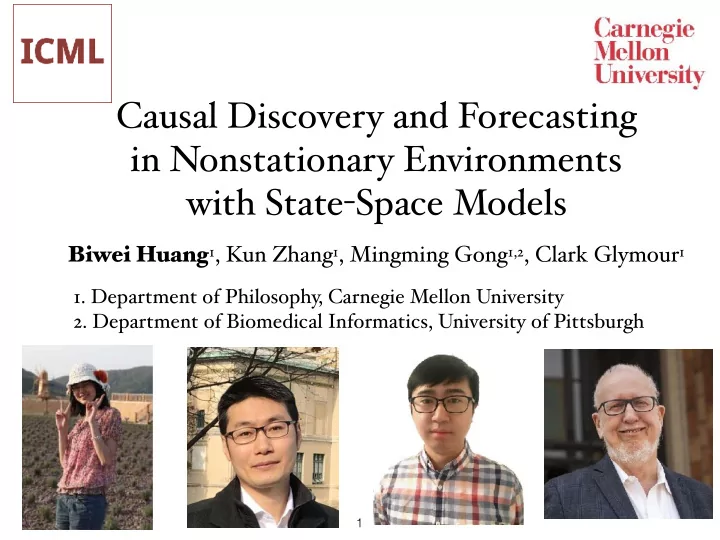

Causal Discovery and Forecasting in Nonstationary Environments with State - Space Models Biwei Huang 1 , Kun Zhang 1 , Mingming Gong 1,2 , Clark Glymour 1 1. Department of Philosophy, Carnegie Mellon University 2. Department of Biomedical Informatics, University of Pittsburgh 1
Two tasks: GDP 1. Identify time - varying Inflation causal relations Economic growth Unemployment 2. Forecast the values of variables of interest • Forecasting benefits from causal knowledge ‣ Each causal module changes independently ‣ Causal knowledge makes the forecasts more interpretable
Time - varying causal model: with • and change over time where 3
Causal Model, Identifiability, and Estimation • Goal : Find time - varying causal relations & make prediction • Causal relations change over time • Model : causal coe ffi cients modeled by autoregressive models • Identifiability : The causal model identifiable if the underlying causal structure is acyclic • Model Estimation : A specific nonlinear state - space model • Estimated by Stochastic approximation EM with Conditional particle filter
Forecasting with time - varying causal model ‣ T reat forecasting as a Bayesian inference problem in the causal model ‣ Metropolis - Hastings to forecast 5
Ours Causal discovery: LiNGAM 0.9 0.9 IB MC F1 score F1 score CD-NOD 0.7 0.7 0.5 0.5 Ours: highest F1 score! 0.3 0.3 500 1000 1500 2000 500 1000 1500 2000 Sample size Sample size (b) Both b and 2 change (a) Only b changes Forecasting: 0.8 1.8 Ours Lasso 0.7 1.6 Window Kalman SSM(CPF) 0.6 1.4 RMSE RMSE GP Ours: lowest RMSE! 0.5 1.2 0.4 1 0.3 0.8 500 1000 1500 2000 500 1000 1500 2000 Sample size Sample size (a) Only b changes (b) Both b and 2 change 6
Macroeconomics data (quarterly data, 1965-2017, USA) GDP Inflation Economic growth Unemployment RMSE of the forecasts on inflation (2007 - 2017).
Poster #73 Conclusion ‣ A unified framework for causal discovery and forecasting ‣ Establish the identifiability results, even when data is conditional Gaussian Future work ‣ Improve the scalability ‣ Nonlinear causal relationships, partially observable processes, and causal models with instantaneous cycles… 8
Recommend
More recommend